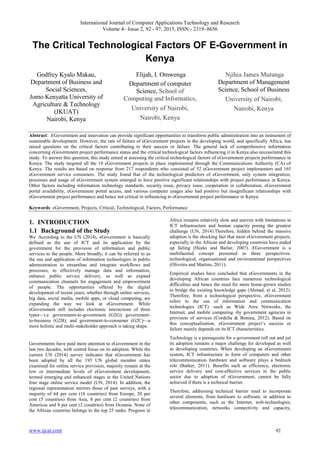This document discusses a study that aimed to assess the critical technological factors influencing the performance of eGovernment projects in Kenya. It provides background on eGovernment and discusses challenges in its implementation in developing countries. The study found that of the technological predictors of eGovernment projects in Kenya, only system integration, processes and usage of the eGovernment system had statistically significant positive relationships with project performance. Other factors like standards, security, privacy, and access had positive but insignificant relationships with performance.





![International Journal of Computer Applications Technology and Research
Volume 4– Issue 2, 92 - 97, 2015, ISSN:- 2319–8656
www.ijcat.com 97
including information technology standards,security
issue,privacy issue, cooperation or collaboration,
eGovernment portal availability, eGovernment portal access,
and various computer usages emerged to have also positive
but insignificant relationships with project performance and
deemed less important in predicting eGovernment projects
performance in Kenya.
6. RECOMMENDATIONS
Based on good practices from around the world, and the
literatures reviewed in the study, effective e-government
development depends on not only organizational and other
environmental dimension factors, but also a robust ICT
backbone. The UN(2014) survey also emphasise the need for
proper national ICT policy and e-government strategy, backed
by robust ICT infrastructure, adequate human capital and
online service delivery, as of critical importance to the
development of effective e-government for a sustainable and
desirable future in the developing world.
Project implementers and e-service users in Kenya should
therefore concentrate in managing the above highlighted
critical technological factors because they determine
eGovernment project implementation, adoption and use and
hence eventual performance outcomes in Kenya. Researchers
should conduct further studies in other settings and involving
larger samples of eGovernment project stakeholders in order
to explore all critical factors within the developing world
contexts. This is very necessary because the current study
only focussed on technological factors only. The critical
environmental and organisational factors need to be
highlighted too. These three dimensions have been noted to
contain the factors behind the high failure rates of
eGovernment projects in developing nations.
7. REFERENCES
[1] Agresti, A. (2002). Categorical Data Analysis (2nd
Edition ed.). RW: Mee.
[2] Ahmad, M. O. Markkula, J. and Oivo, M. (2012).
Factors Influencing the Adoption of eGovernment
Services in Pakistan. Paper presented at the Proceedings
of the 9th European, Mediterranean and Middle Eastern
Conference on Information Systems, Munich, Germany.
[3] Barker, J. (2011). The technology–organization–
environment framework. In Information Systems Theory:
Explaining and Predicting our Digital Society (Dwivedi,
Y., Wade, M. and Schneberger, S. Eds.), pp. 231-246,
Springer, New York.
[4] Basu, S. (2004). E-government and developing countries:
an overview. International Review of Law, Computers &
Technology, 18, 109-132.
[5] De Vaus, D. A. (2001). Research design in social
research London: SAGE.
[6] Gil-Garcìa, J. R., & Pardo, T. A. (2005). E-government
success factors: Mapping practical tools to theoretical
foundations. Government Information Quarterly, 22,
187-216.
[7] Heeks, & Bailur, S. (2007). Analyzing e-government
research: Perspectives, philosophies, theories, methods,
and practice. Government Information Quarterly, 24,
243-265.
[8] Heeks. (2003). Most egovernment-for-development
projects fail: how can risks be reduced? : Institute for
Development Policy and Management.
[9] Klischewski, R., & Scholl, H. J. (2008). Information
quality as capstone in negotiating e-overnment
integration, interoperation and information sharing.
Government, an International Journal, 5, 203-225.
[10] Mutula, S. M. (2008). Africa’s e-government status with
developed and transitional nations. Information
Management & Computer Security 16 (3), 235-250.
[11] Oliveira, T., & Martins, M., F. . (2011). Literature
Review of Information Technology Adoption Models at
Firm Level. The Electronic Journal Information Systems
Evaluation 14(1), pp110- 121.
[12] Rohillo Pradeep (2010). Research Methodology. APH
Publishing Corporation. New Delhi.
[13] Saunders, M., Lewis, P., & Thornhill, A. (2003).
Research methods for business students (3rd edition ed.).
Harlow: Prentice Hall.
[14] Schaper, L. K., & Pervan, G. P. (2007). ICT and OTs: A
model of information and communication technology
acceptance and utilisation by occupational therapists.
International Journal of Medical Informatics, 76, 212-
221.
[15] Schedler, K., & Schmidt, B. (2004). Managing the e-
government organization. International Public
Management Review 1-20
[16] Schurink, E. (2009). Qualitative Research Design as Tool
for Trustworthy Research. The Journal of Public
Administration, 44 (4.2) 803-823.
[17] Schware, R., & Deane, A. (2003). Deploying e-
government programs: The strategic importance of I
before e. Info, 5(4), 10-19.
[18] UN. (2012). United Nations E-government Survey 2012.
Retrieved Accessed: 03 May, 2012
http://unpan1.un.org/intradoc/groups/public/documents/u
n/unpan048065.pdf
[19] UN. (2014). United Nations E-government Survey 2014.
Retrieved Accessed: 10 January, 2014
http://unpan3.un.org/egovkb/Portals/egovkb/Documents/
un/2014-Survey/E-Gov_Complete_Survey-2014.pdf
[20] Venkatesh, Morris, M., Davis, G., & Davis, F. (2003).
User Acceptance of Information Technology: Toward a
Unified View. MIS Quarterly, 27, 425-478.](https://image.slidesharecdn.com/ijcatr04021003-150312084640-conversion-gate01/85/The-Critical-Technological-Factors-OF-E-Government-in-Kenya-6-320.jpg)